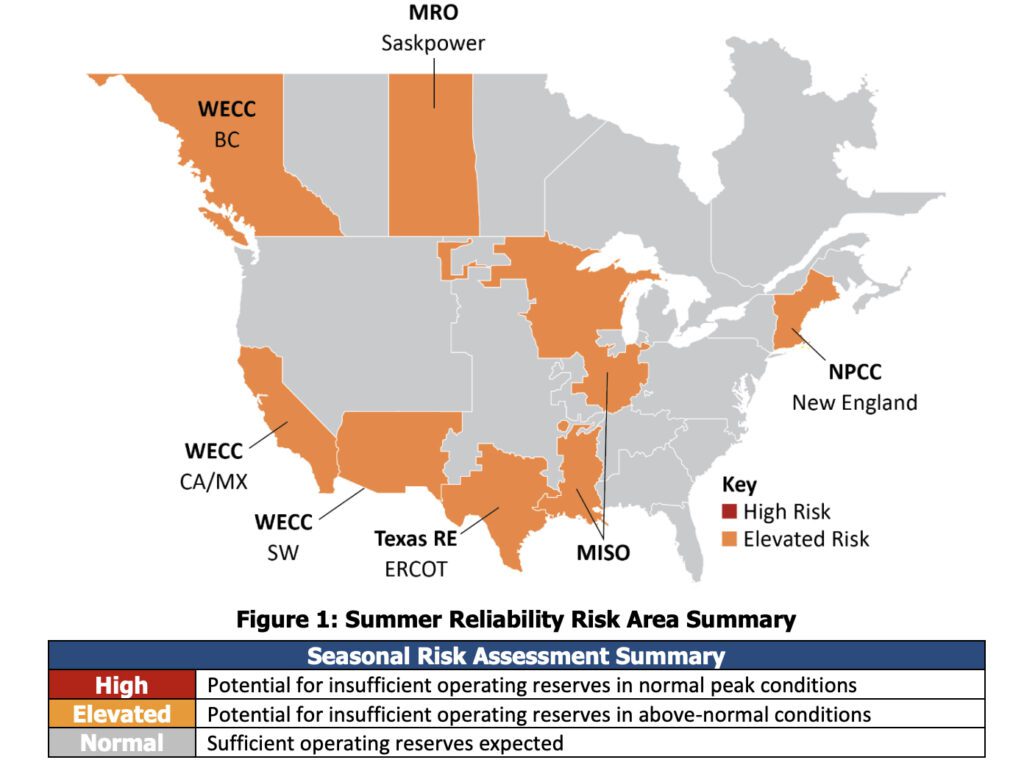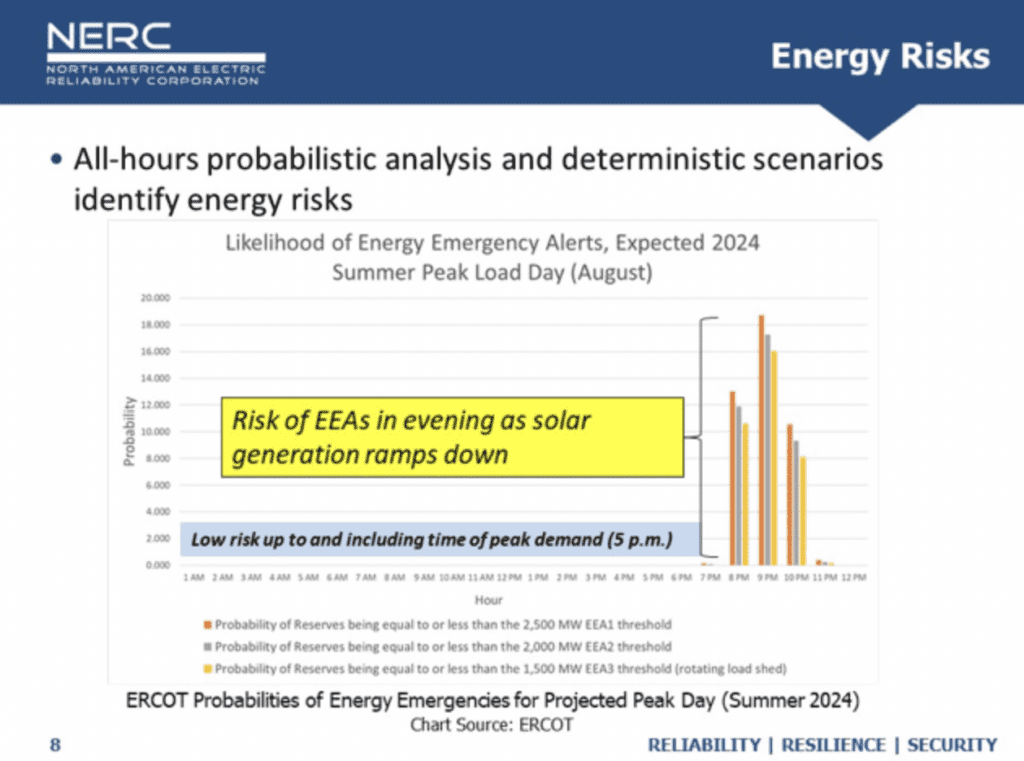NERC: Summer Grid Outlook Improved But Still Vulnerable to Extreme Weather, Demand Growth Spikes
NERC: Summer Grid Outlook Improved But Still Vulnerable to Extreme Weather, Demand Growth Spikes
All regions across the bulk power system (BPS) are generally prepared to meet resource adequacy criteria to meet normal peak demand this summer, but ongoing concerns about extreme weather events, rapid demand growth, and systemic vulnerabilities still pose significant risks for supply shortfalls and grid reliability, the North American Electric Reliability Corp. (NERC) has warned.
NERC’s May 15–issued 2024 Summer Reliability Assessment points to significant regional variations that could influence grid stability under more extreme conditions. Wildcard risks include variable renewable energy outputs, reduced capacity stemming from the retirement of major generators, surging demand growth, transmission and import limitations, drought complications, and other weather-related risks, including extended heat waves.
A Regional Breakdown
NERC generally expects the Midcontinent Independent System Operator (MISO) region to have sufficient resources, including firm imports for normal summer peak demand. However, it suggests new solar and natural gas–fired generation and additional demand response (DR) resources are offset by generator retirements, lower firm imports, and increased reserve requirements. In particular, the region could suffer if wind generator performance flails during periods of high demand. MISO, notably, is cognizant of its reliability vulnerabilities, and it has taken concerted steps to guard against several critical challenges.
In New England, Constellation’s pending retirement of two natural gas–fired units at the 1.4-GW Mystic Generating Station in Boston on May 31 could push ISO New England (ISO-NE) to “resort to operating procedures for obtaining resources or non-firm supplies from neighboring areas during periods of above-normal peak demand or low-resource conditions.”
The Electric Reliability Council of Texas (ERCOT) is grappling with “vigorous growth in both loads and solar and wind resources,” NERC noted. On April 23, ERCOT CEO Pablo Vegas reported the grid is bracing for exponential demand growth driven by crypto mining, data centers and artificial intelligence (AI), electrification in the oil and gas industries, and potential impacts from the hydrogen economy.
The grid operator and reliability entity said it would adapt and plan differently to meet a load growth projection of about 152 GW by 2030—40 GW higher than the same forecast a year before. NERC, in its assessment, warned the region already faces risks of emergency conditions in the summer evening hours, as solar generation ramps down. But contributing to the elevated risk is a potential need, under certain grid conditions, “to limit power transfers from South Texas into the San Antonio region,” it noted. These grid conditions can occur when demand is high and wind and solar output is low in specific areas, straining the transmission system and necessitating South Texas generation curtailments and potential firm load shedding to avoid cascading outages. “Conditions could cause overloads on the lines that make up the South Texas export and import interfaces, necessitating South Texas generation curtailments and potential firm load shedding to avoid cascading outages,” it said.
In the West, California will benefit from new solar and battery resources—which have ramped up on-peak reserve margins by 47%, and the region’s hydropower resources appear healthy. However, the region is banking on new generation additions. “Probabilistic assessments performed by WECC show that the risks of load loss are similar to Summer 2023, ranging from negligible to 0.8 loss of load hours (LOLH) depending on how much of the area’s new solar and battery resources (totaling nearly 6 GW of nameplate capacity) are completed over the summer,” NERC said. Extreme demand could pose risks in the Baja (Mexico) portion. In the Southwest, where an ongoing severe drought persists, extreme conditions—surging demand or low resource output—could require additional non-firm imports from neighboring areas.
A significant drought is also posing risks for British Columbia, which has seen a dramatic upsurge of peak demand (600 MW or about 7.4%) since 2023 and contributed to a drop in the anticipated reserve margin by more than 10 percentage points. Saskatchewan, a winter-peaking area, also faces significant demand during extremely hot weather conditions. “The probability of experiencing a shortage in operating reserves during peak load periods, or EEAs, may increase if significant generation forced outages happen at the same time as planned maintenance outages during the high-demand months of June through September,” NERC said.

A Complex Risk Environment
NERC’s 2024 assessment is notably less intense than the Electric Reliability Organization (ERO) enterprise’s past summer evaluations, which have flagged energy shortfalls for often large swathes of the North American bulk power system.
“All of our assessment areas have adequate resources for normal peak load conditions. There’s been a lot of new resource additions, a lot of solar came on the system, and we’ve had more capacity stick around in some areas that were of concern in the past and that has helped,” Mark Olson, NERC’s manager of Reliability Assessments, said in a call with reporters on Wednesday. “There’s also been more demand-side management program enrollment in many of the assessment areas.”
However, as in the past, NERC notes the potential for extreme temperature across much of North America. “A large part of North America could be at risk of supply shortfalls during heat waves and extreme summer conditions that can affect generation, wind output, or the transmission systems,” he said. Additionally, although the North American Drought Monitor indicates some improvement in drought conditions compared to last year, moderate to extreme drought still persists in much of Canada and the US Southwest, he noted. “Drought can affect some resource adequacy and bulk power system reliability by contributing to high temperatures in wide areas also elevates wildfire risk, which can affect transmission, and it can and of course route can affect the hydroelectric output,” he said.
This year, however, the power sector is also grappling with distinct challenges. NERC has already flagged many of these, which it suggests are contributing to a “hypercomplex risk” environment that could affect grid reliability and security.
| See more: Eight Critical REliability Challenges NERC is Confronting for Grid Stability. |
A Clear Signal: Demand Growth
According to Olson, a significant factor relates to growing demand. While demand growth is not uniform everywhere, “there’s a very clear signal of demand growth,” he noted. Demand growth is especially notable in ERCOT, the Southwest Power Pool (SPP), and British Columbia. “Drivers for demand growth in the areas vary and conclude demographic changes and economic activity, but also new data centers and cryptocurrency mining facilities in some areas are contributing higher to higher demand forecasts,” he noted.
In April, NERC CEO Jim Robb honed in on this point, noting the rapid expansion of energy-intensive operations introduces variability and unpredictability into the grid, complicating demand management and planning, he said. “You know, the electric industry hasn’t grown appreciably over the last 10 to 20 years because of all the success we’ve had around energy efficiency and demand response, appliance turnover. The growth rate that we forecasted last year, and peak load growth, versus the changes in the previous 10 years is like twice—2x—what it was,” he said.
Olson, however, also noted that resource additions in many areas previously identified at risk last year now exceed rising demand forecasts. “I’ll note that in ERCOT, where some of the most data center and crypto mining development is occurring, and some of these large loads participate in demand side management programs that can help offset their impact,” he said. The Southwest Power Pool has also added significant wind capacity and can now count on more generators than it did last year, he noted. New firm transfer agreements, growth in distributed resources, and postponed generator retirements are also contributing to an overall improved resource outlook for the upcoming summer, he said.
Overall capacity additions are mounting at a record pace. For example, since last summer, 25 GW of nameplate solar capacity have been added to the BPS, up from 19 GW the year before, Olson noted. “And notice, really significant amounts of batteries were added in ERCO, California, and the California Mexico assessment area.”

Energy Risks Persist
Still, energy risks persist, NERC warned. Energy risks are potential future electricity supply shortfalls under normal as well as extreme conditions, essentially presenting a “forward-looking snapshot” of resource adequacy that is tied to industry forecasts of electricity supplies, demand, and transmission development.
Olson on Wednesday pointed to a slide depicting ERCOT’s energy risk. “As we said, all areas have adequate resources, but energy risks emerge in areas that do not have enough dispatchable generators or dispatchable resources to counter periods when solar, wind, or hydro output are low. And so what this slide is showing is the results of ERCOT’s probabilistic reserve risk model, which is part of their seasonal assessment process developed, and what this simulation shows is an elevated risk of having to declare energy emergency alerts during evening hours on the peak load day in August, which is their summer peak load month.” ERCOT’s risk can reach up to an 18% likelihood of an energy emergency alert between 8 p.m. and 10 p.m. as solar generation diminishes, he said.

Other risks include unexpected tripping of inverter-based resources (IBRs). NERC has long warned about these risks and has recently set out to address them. IBRs respond differently to grid disturbances, he explained. “There’s been problems with ride-through in the past, leading to large amounts of solar to drop offline, and now that is extended—battery resources as well could be affected by that. So it’s something for operators to be aware of,” he said.
NERC said it does not foresee any problems for the upcoming summer related to the availability of natural gas. “There’s high levels of storage in the natural gas stores. What needs to be stressed with both grid and gas system operators is the importance of coordination for maintenance periods on the gas systems so that we can ensure fuel availability for gas-fired generation,” Olson said.
Finally, NERC flagged ongoing impacts from the supply chain crunch, warning that it could cause construction delays. Supply chain issues are already “delaying some new resource and transmission projects, raising concerns that some may not be completed prior to peak summer conditions,” NERC noted. Lead times for transformers, circuit breakers, transmission cables, switchgear, and insulators have “increased significantly since 2020,” it said.
Olson, however, also pointed to difficulties in procuring PV panels, warning that longer lead times could affect new project construction, existing asset upgrades, pre-seasonal maintenance, and the interconnection of new resources and customers.
Olson noted that last year, “there were quite a number of resources that were still in development to connect over the course of the summer, and really over the over the course of the year. What wound up being connected was less than what was projected by, you know, by a sizable amount. The so we’re in what we’re interested in is in areas particularly risk areas,” he explained.
Areas that could bear the brunt of supply chain delays may be focused in the Western Interconnection, where “several gigawatts of new battery resources and some solar resources are in development,” Olson added. “Those areas are planning on those [assets] being available to meet demand when summer conditions get their toughest, which is kind of late in the summer.”
NERC suggests long-term mitigation strategies should include lengthening ongoing construction timelines and ordering surplus inventory in advance. “Should project delays emerge, affected GOs and Transmission Owners (TO) must communicate changes to BAs, Transmission Operators (TOP), and RCs so that impacts are understood and steps are taken to reduce risks of capacity deficiencies or energy shortfalls,” it said.
—Sonal Patel is a POWER senior editor (@sonalcpatel, @POWERmagazine).
SHARE this article





